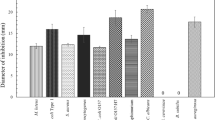Summary
We have identified a strain of the yeast Pichia acaciae which produces a “killer” toxin active against the yeast Debaryomyces tamarii. The killer phenotype was associated with the presence of two DNA plasmids, pPacl-1 (13.6 kilobase pairs) and pPacl-2 (7.3 kilobase pairs). P. acaciae strains, cured of these plasmids by irradiation with ultraviolet light, lacked killer activity and were sensitive to toxin produced by the parental strain. A partially cured strain, GS-1215, missing only the smaller plasmid, pPacl-2, also exhibited loss of both toxin activity and immunity. Exonuclease studies revealed that both plasmids were linear double-stranded DNA molecules with 5′ protected ends. The P. acaciae system differs from that of the well-studied Kluyveromyces lactis “killer” system both in the range of susceptible strains and in the sizes of the plasmids involved. Our studies contradict previous reports that Pichia killer systems are invariably chromosomal.
Similar content being viewed by others
References
Gunge N (1986) Yeast 2:153–162
Gunge N, Tamaru A, Ozawa F, Sakaguchi K (1981) J Bacteriol 145:382–390
Kitada K, Hishinuma F (1987) Mol Gen Genet 206:377–381
Lehmann PF, Lemon MB, Ferencak WJ (1987) Mycologia 79:790–794
Ligon JM, Bolen PL, Hill DS, Bothast RJ, Kurtzman CP (1989) Plasmid 21:185–194
Maniatis T, Fritsch F, Sambrook J (1982) Molecular cloning: a laboratory manual. Cold Spring Harbor Laboratory, Cold Spring Harbor, New York
Meinhardt F, Kempken F, Esser K, (1986) Curr Genet 11:243–246
Morace G, Archibusacci C, Sestito M, Polonelli L (1984) Mycopathologia 84:81–85
Polonelli L, Archibusacci C, Sestito M, Morace G (1983) J Clin Microbiol 17:774–780
Radler F, Pfeiffer P, Dennert M (1985) FEBS Lett 29:269–272
Sawant AD, Abdelal AT, Ahearn DG (1988) Appl Environ Microbiol, 54:1099–1103
Shepherd HS, Ligon JM, Bolen PL, Kurtzman CP (1987) Curr Genet 12:297–304
Stam JC, Kwakman J, Meijer M, Stuitje AR (1986) Nucleic Acids Res 14:6871–6884
Starmer WT, Ganter PF, Aberdeen V, Lachance M, Phaff HJ (1987) Can J Microbiol 33:783–796
Tokunaga M, Wada N, Hishinuma F (1987) Nucleic Acids Res 15:1031–1046
Wickner RB (1976) Bacteriol Rev 40:757–773
Worsham PL, Goldman WE (1988) Mol Gen Genet
Zorg J, Kilian S, Radler F (1988) Arch Microbiol 149:261–267
Author information
Authors and Affiliations
Additional information
Communicated by K. Wolf
Rights and permissions
About this article
Cite this article
Worsham, P.L., Bolen, P.L. Killer toxin production in Pichia acaciae is associated with linear DNA plasmids. Curr Genet 18, 77–80 (1990). https://doi.org/10.1007/BF00321119
Received:
Issue Date:
DOI: https://doi.org/10.1007/BF00321119




